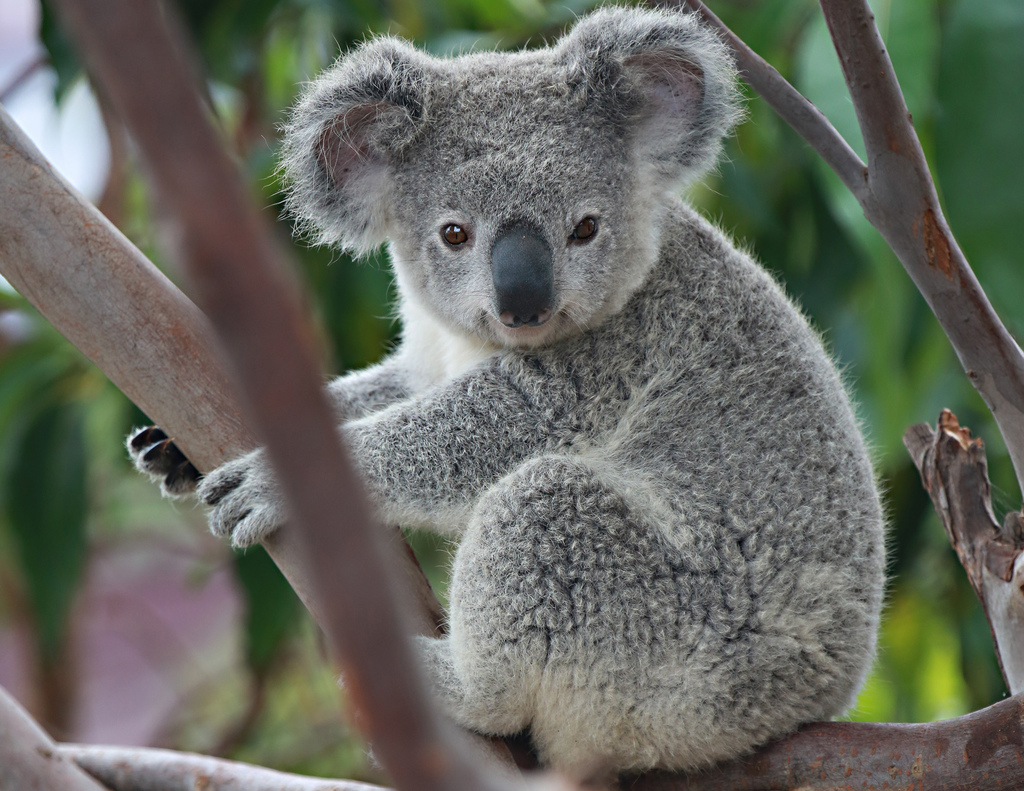
Koala(Phascolarctos cinereus)
Phylum —chordata
Class — mammalia
Order — diprotodontia
Family — phascolarctidae
Genus – phascolarctos
Appearance
The Koala is a stocky animal with a large head and vestigial or non-existent tail. It has a body length of 60–85 cm (24–33 in) and a weight of 4–15 kg (9–33 lb). The species is sexually dimorphic, with males 50% larger than females. Males are further distinguished from females by their more curved nosesand the presence of chest glands, which are visible as hairless patches.
The pelage of the Koala is thicker and longer on the back, and shorter on the belly. The ears have thick fur on both the inside and outside. The back fur color varies from light grey to chocolate brown. The belly fur is whitish; on the rump it is dappled whitish, and darker at the back. The Koala has the most effective insulating back fur of any marsupial and is highly resilient to wind and rain, while the belly fur can reflect solar radiation. The Koala's curved, sharp claws are well adapted for climbing trees. The large forepaws have two opposable digits (the first and second, which are opposable to the other three) that allow them to grasp small branches. The animal has a sturdy skeleton and a short, muscular upper body with proportionately long upper limbs that contribute to its climbing and grasping abilities. Additional climbing strength is achieved with thigh muscles that attach to the shinbone lower than other animals.
Habitat
The ideal habitat of Koala is eucalyptus forests, humid woodlands and riparian areas. The species is distributed across eastern and southeastern Australia, including northeastern, central and southeastern Queensland, eastern New South Wales, Victoria as well as southeastern parts of South Australia.
Behavior
Koalas are asocial animals, congregating only during the breeding season. They usually form large, loosely organized groups in areas with abundant suitable trees, with a single individual per tree. During the rest of the year, Koalas tend to live solitarily, showing very little social behavior. They are arboreal animals, dwelling in trees. Koalas are exceptionally good climbers. Meanwhile, when on the ground, they are very slow walkers. During the daytime hours, these nocturnal animals usually sleep in the fork of eucalyptus trees.
Normally, Koalas are quiet animals. However, when threatened or alarmed, they typically give out a call, reminding cry of a human baby, and accompanying it by shaking. In addition, during the breeding season, males of this species begin to emit bellowing calls. Koalas also scent-mark their trees, which is a form of communication.
Diet
They are herbivorous animals, feeding primarily upon leaves of eucalyptus tree. Meanwhile, they consume leaves of 30 various species of eucalyptus tree. In addition, they supplement their usual diet with melaleuca, foliage from leptospermum and acacias.
Reproduction
These animals have polygynous mating system with the dominant male, mating with most of females. Koalas mate from December to March. Gestation period in Koalas lasts for only 35 days, yielding a single baby. During the first 5-6 months of its life, the joey lives in the pouch of its mother, feeding exclusively on milk. By the age of 6 months, the young is weaned. The young then starts feeding upon pap - partially digested vegetation, found in excrement of its mother. At 7 months old, the baby comes out of the pouch of its mother, beginning to cling to her back. Then, at about 1 year old, young Koala becomes independent, after which the youngster typically stays with its mother for another few months before it leaves. Male Koalas reach sexual maturity by 3-4 years old while females are mature at 2-3 years old.
Incaptivity
The average lifespan of a Koala is about 10 years.
They are kept only in specialized zoos. The explanation is contained in the nutrition features of this amazing animal. Koalas are extremely fastidious in food: they feed exclusively on eucalyptus leaves. The Koala's digestive tract is designed so that it can't digest other food. Therefore, even a hungry Koala is not looking for a replacement for eucalyptus leaves. A Koala eats 0.5-1.1 kg of eucalyptus leaves per day. At the same time, out of 800 species of eucalyptus, Koalas prefer only 120, and choose only young leaves.
If you are able to get a regular supply of at least 1 kg per day of fresh eucalyptus leaves of a strictly defined type, you can try to keep a Koala at home!
Koalas are perfectly tamed. However, you should take them in your hands carefully, as they have very sharp claws. In captivity, Koalas are very attached to those who care for them, and often behave like spoiled children: they "cry" when they are left, and calm down if they are petted. And if they are, on the contrary, too stick, they are protected by teeth and claws.
 Russian
Russian
 English
English
























